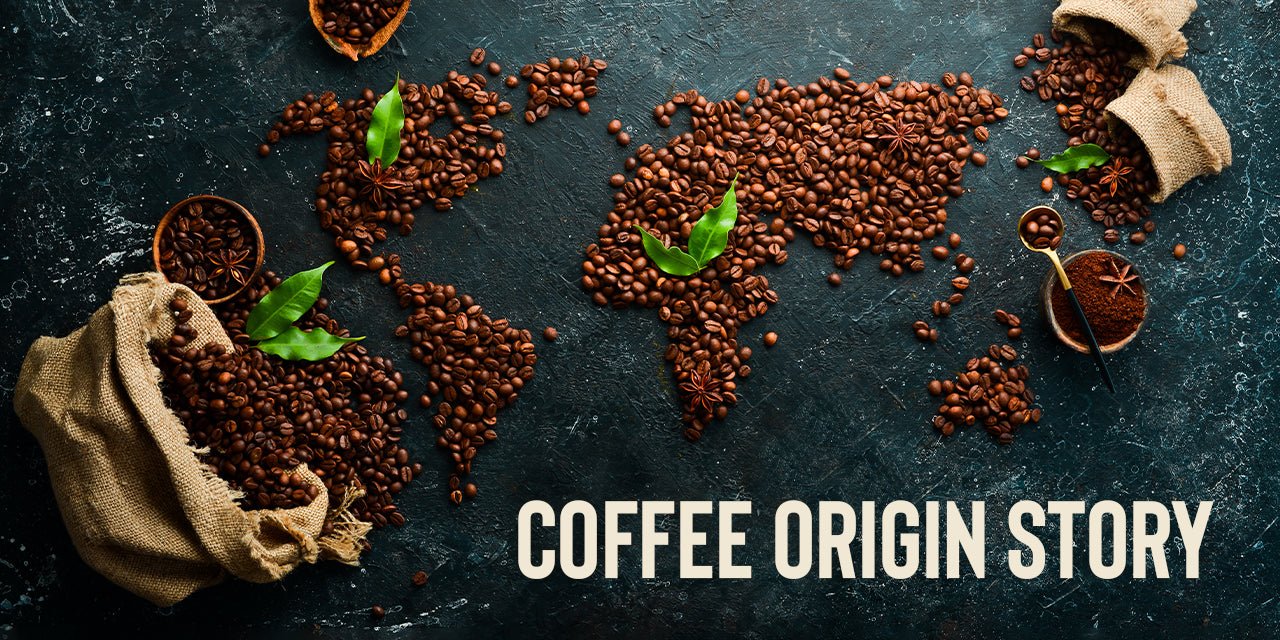How did a bean inside a red cherry come to be what it is today - one of the most popular beverages in the world?
In this article on the coffee origin story, we delve into the origins of this beloved beverage, tracing its journey through time, cultures and beautiful geographical landscapes.
Coffee Origin Story in Three Parts
This exploration will walk you through the coffee's discovery in Ethiopia. Then, the history of coffee as the seeds were passed on through continents and its subsequent entry to India. From there, we will continue its saga as it flourished in the Bababudangiri hills in Southern India and came to be in your cup after the three waves of coffee revolution.
1. The Discovery

According to popular legend, a 9th-century goatherd named Kaldi from Ethiopia discovered the first-ever coffee beans. He noticed first that his goats became energetic after nibbling on the red cherries from a certain shrub. Intrigued by this incident, Kaldi tasted the berries himself. This first bite into the cherry started our modern coffee consumption.
The discovery soon reached the local monastery, where monks recognised the potential of these berries. They began to incorporate coffee into their drinks to help them stay awake during long hours of prayer and contemplation.
From Ethiopia, coffee found its way to the Arabian Peninsula. After making Yemen its initial sanctuary, coffee was embraced by people across the Middle East. Soon, the beverage became a symbol of social connection and intellectual exchange. One could find coffeehouses, reminiscent of modern-day cafes, as a hub for conversation, music and poetry.
2. The Legend of Baba Budan

Baba Budan, a Sufi Saint from Chikkamagalur is believed to have brought the first-ever coffee beans to India. According to the legend, Baba Budan was on a pilgrimage to Mecca. He encountered the stimulating brew of coffee and was captivated by it. So, he decided to bring the beans back to his homeland.
However, coffee cultivation was a closely guarded trade in the Arab world, and the export of fertile beans was strictly forbidden. Baba Budan, nonetheless, smuggled seven coffee seeds back to India.
Upon returning, he planted these beans in the fertile soil of Chandragiri Hills, giving birth to India's first coffee plantation in the 17th century.
As the coffee plants flourished in the Western Ghats, the British recognized the potential of Indian soil for coffee cultivation. They established coffee plantations and commercialised the plants. By the 19th century, coffee plantations flourished in the hilly regions of Karnataka, Kerala and Tamil Nadu.
Check Out Budan, A Brand Named After the Lore →
3. The Three Waves of Coffee

The First Wave: The first wave of coffee thrived when the British Businessmen established coffee plantations and commercialised the coffee plants. They introduced modern processing techniques to improve production.
This wave made coffee an easily consumable product and was sold in retail stores. The beans were roasted and sold both in the form of whole beans and ground coffee.
The Second Wave: The second wave of coffee in India coincides with the global specialty coffee movement. This began when coffee consumers wanted more than commercialised coffee. Here, the importance shifted from quantity to quality.
During this period, small-scale farms and estates started to experiment with coffee. It includes cultivating different coffee varieties and processing them via alternative methods. The methods played a huge role in bringing out the flavours inherent to Indian coffee.
The Third Wave: The third wave coffee movement started in India in the 2010s. We are currently progressing in this wave at a fast pace.
This movement is all about appreciating the nuances of coffee and understanding what goes on behind the scenes. So, there is a focus on its origin, an emphasis on overall education about coffee and its freshness. Coffee lovers have taken to home-brewing specialty coffee to appreciate the flavours making the movement bigger than ever.
As a result, artisanal roasters have emerged across the country. They work meticulously to source coffee beans from micro-lots and estates. Then, they roast the coffee beans to bring out their unique flavours and provide detailed information about the coffee's journey.
Read more about the Three Waves of Coffee Here →
Closing Lines
In the journey of coffee from the bean's discovery to the bustling coffeehouses, coffee is more than a simple beverage in a cup. As we sip our favourite brew, whether meticulously brewed at home or savoured at a local cafe, we are partaking in a tradition that spans centuries and continents.
Furthermore, home brewing, a practice deeply embedded in the coffee origin story, signifies the democratisation of good quality coffee. From exploring traditional methods like Ibrik, the South Indian Filter Kaapi maker to AeroPress and other modern brewers, coffee enthusiasts are becoming architects of their own coffee experience.


























